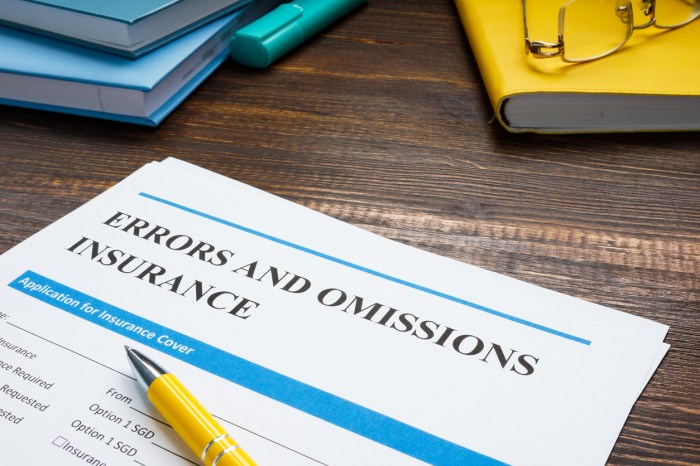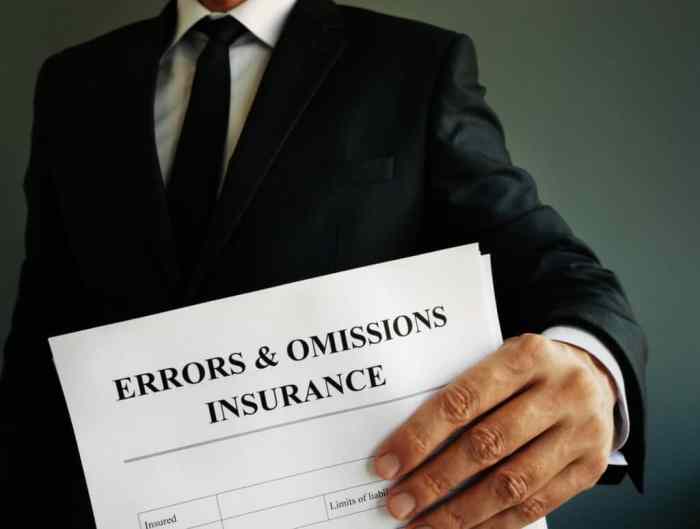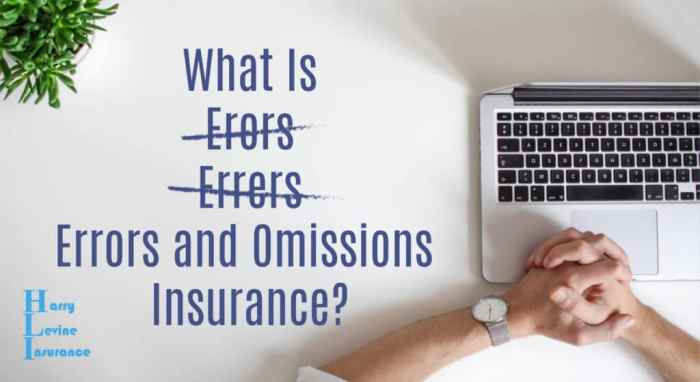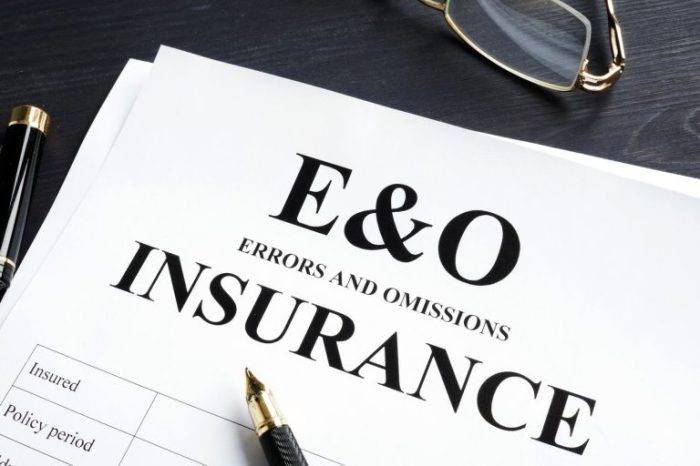In today’s rapidly evolving business landscape, safeguarding your enterprise against potential risks and liabilities is paramount. Errors and omissions (E&O) insurance plays a crucial role in protecting your company from financial losses arising from mistakes, oversights, or negligence in the delivery of professional services.
This comprehensive guide will delve into the intricacies of E&O insurance, empowering you with the knowledge to make informed decisions and choose the optimal policy for your business needs. We will explore the different types of E&O insurance available, the factors to consider when selecting a policy, and the steps involved in filing a claim.
Defining Errors and Omissions Insurance

Errors and omissions insurance (E&O) is a type of professional liability insurance that protects businesses and individuals from financial losses resulting from mistakes, errors, or omissions in their professional services.
Examples of errors and omissions that can be covered by insurance include:
- Providing incorrect advice or guidance to clients
- Failing to meet contractual obligations
- Negligence in performing professional duties
Having errors and omissions insurance is crucial for businesses and individuals providing professional services, as it helps protect them from financial risks and potential lawsuits.
Types of Errors and Omissions Insurance

Errors and omissions insurance, also known as professional liability insurance, protects businesses from financial losses resulting from mistakes, errors, or omissions in their professional services.
There are different types of errors and omissions insurance available, each tailored to the specific needs of different businesses and professions.
Professional Liability Insurance
- Covers professionals such as accountants, lawyers, doctors, and architects.
- Protects against claims of negligence, errors, or omissions in the performance of professional services.
- Example: A doctor may need professional liability insurance to protect against claims of misdiagnosis or improper treatment.
Cyber Liability Insurance
- Protects businesses from financial losses resulting from data breaches, cyber attacks, and other cyber-related incidents.
- Covers costs associated with data recovery, legal defense, and regulatory fines.
- Example: A business that stores customer data online may need cyber liability insurance to protect against the financial consequences of a data breach.
Directors and Officers Liability Insurance (D&O)
- Protects directors and officers of companies from personal liability for claims arising from their management decisions.
- Covers legal expenses, settlements, and judgments related to allegations of mismanagement, breach of fiduciary duty, or other wrongful acts.
- Example: A board of directors may need D&O insurance to protect themselves from lawsuits alleging mismanagement or financial improprieties.
Employment Practices Liability Insurance (EPLI)
- Protects businesses from claims related to employment practices, such as discrimination, harassment, wrongful termination, and retaliation.
- Covers legal expenses, settlements, and judgments associated with employment-related lawsuits.
- Example: A company with a large number of employees may need EPLI insurance to protect against claims of workplace discrimination or harassment.
Choosing the Right Errors and Omissions Insurance
When choosing an errors and omissions insurance policy, it’s crucial to consider several factors:
-*Coverage
Ensure the policy covers the specific types of errors and omissions that your business is exposed to.
-*Limits of Liability
Determine the maximum amount the insurance company will pay for a claim.
-*Deductibles
Understand the amount you’ll be responsible for paying before the insurance coverage kicks in.
-*Premiums
Compare premiums from different insurers to find the best value for your coverage.
-*Financial Stability
Check the financial stability of the insurance company to ensure they can fulfill their obligations.
Tips for Comparing Different Policies
-*Read the Policy Carefully
Review the policy documents thoroughly to understand the terms and conditions.
-*Compare Coverage
Examine the types of errors and omissions covered by each policy.
-*Consider Exclusions
Identify any specific exclusions or limitations that may apply.
-*Evaluate Financial Strength
Assess the financial stability of each insurer.
-*Seek Professional Advice
Consult with an insurance broker for guidance and assistance in choosing the right policy.
Importance of Working with an Insurance Broker
An insurance broker can provide valuable assistance by:
-*Assessing Your Needs
Identifying the specific risks your business faces and recommending appropriate coverage.
-*Negotiating Coverage
Negotiating with insurance companies on your behalf to secure the best possible terms.
-*Managing Claims
Assisting you in filing and managing claims efficiently.
-*Providing Ongoing Support
Offering ongoing support and guidance throughout the life of your policy.
Filing an Errors and Omissions Claim

Filing an errors and omissions claim can be a complex process, but it is essential to maximize your chances of a successful outcome.
Here’s a step-by-step guide to help you through the process:
1. Notify your insurance company promptly. The sooner you notify your insurance company of a potential claim, the better. This will give them time to investigate the claim and begin the process of settlement.
2. Gather evidence to support your claim. This may include documentation of the error or omission, correspondence with the client, and any other relevant materials.
3. Submit a formal claim to your insurance company. This claim should include a detailed description of the error or omission, the damages that have been incurred, and the amount of compensation you are seeking.
4. Cooperate with the insurance company’s investigation. The insurance company will need to investigate the claim to determine whether it is covered by your policy. You should provide them with all of the information they request and answer their questions honestly.
5. Negotiate a settlement. Once the insurance company has completed its investigation, they will make an offer to settle the claim. You should carefully review the offer and negotiate with the insurance company if you believe it is not fair.
Tips for Maximizing Your Chances of a Successful Claim
* Keep accurate records of all your work. This will help you to prove your case if you need to file a claim.
- Get everything in writing. This includes agreements with clients, correspondence, and any other relevant documents.
- Be honest with your insurance company. If you try to hide anything, it could jeopardize your claim.
- Hire an attorney if you need help. An attorney can help you to file your claim and negotiate with the insurance company.
Potential Consequences of Not Filing a Claim
If you do not file a claim, you could be held personally liable for any damages that are caused by your error or omission. This could result in a financial loss or even a lawsuit.
Preventing Errors and Omissions
Errors and omissions are a common occurrence in any industry, but they can be particularly damaging to businesses that provide professional services. A single error or omission can lead to lost clients, damaged reputations, and even legal liability.There are a number of common causes of errors and omissions, including:* Lack of training or experience
- Poor communication
- Insufficient documentation
- Human error
There are a number of strategies that businesses can implement to prevent errors and omissions, including:* Providing adequate training and education to employees
- Establishing clear and concise policies and procedures
- Implementing a system of checks and balances
- Encouraging open communication and feedback
- Using technology to automate tasks and reduce the risk of human error
Training and education are essential for preventing errors and omissions. Employees who are properly trained and educated are more likely to understand the risks involved in their work and to take steps to avoid making mistakes.
Role of Training and Education in Preventing Errors and Omissions
Training and education play a critical role in preventing errors and omissions. By providing employees with the knowledge and skills they need to perform their jobs effectively, businesses can reduce the risk of mistakes.Training should be tailored to the specific needs of the business and its employees.
It should cover topics such as:* The company’s policies and procedures
- The risks involved in the work
- How to identify and avoid errors
- How to communicate effectively
- How to use technology effectively
Education is also important for preventing errors and omissions. Employees who are well-educated are more likely to be aware of the latest trends and best practices in their field. This knowledge can help them to identify and avoid potential problems.By
investing in training and education, businesses can reduce the risk of errors and omissions and improve the quality of their work.
Final Conclusion

Remember, the best errors and omissions insurance is the one that aligns seamlessly with your business’s unique requirements. By carefully assessing your risks, understanding the available coverage options, and working with a reputable insurance broker, you can secure the necessary protection to operate with confidence and minimize the financial impact of potential errors or omissions.
Questions and Answers
What is the difference between errors and omissions insurance and professional liability insurance?
While both errors and omissions insurance and professional liability insurance provide coverage for professional negligence, E&O insurance specifically addresses mistakes or omissions in the performance of services, while professional liability insurance covers a broader range of claims, including bodily injury and property damage.
How much does errors and omissions insurance cost?
The cost of E&O insurance varies depending on factors such as the size of your business, the industry you operate in, and the coverage limits you require. It’s advisable to obtain quotes from multiple insurance providers to compare rates and find the most competitive option.
What are the common exclusions in errors and omissions insurance policies?
Typical exclusions in E&O policies include intentional acts, criminal conduct, contractual disputes, and claims arising from the provision of services outside the scope of the insured’s expertise.


